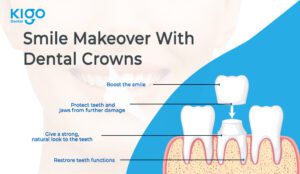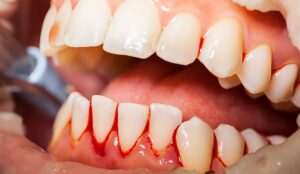Space Maintainer
Uncompromised quality
We use quintessential quality materials and stringent sterilisation protocols to ensure that you don't have any medical or dental complications in future.
Anxiety Free Dentistry
Experience the treatment process in a pleasant atmosphere from handpicked expert clinicians, with unparalleled clinical etiquette, to ensure exemplary health care.
Best in class outcomes
We strive our best, so that we can keep our promise of delivering the individualized smiles that we have reimagined for you with latest techniques and technologies.
Space Maintainer


At Kigo Dental, we understand the importance of maintaining proper spacing and alignment of teeth, especially in growing children. If your child has lost a baby tooth prematurely or requires assistance in preserving space for permanent teeth, our Space Maintainer service is here to help.
Space maintainers are dental appliances specifically designed to hold the space left by a missing tooth, preventing neighboring teeth from shifting into the gap and ensuring that there is adequate room for the permanent tooth to erupt in its proper position. This proactive approach can prevent future orthodontic issues and the need for more extensive treatments down the line.
Our experienced team of dental professionals at Kigo Dental is dedicated to providing exceptional care for your child’s dental health. We understand that each child is unique, and our experts will take the time to assess your child’s specific needs and develop a personalized treatment plan.
Using advanced techniques and materials, our skilled dentists will fabricate a custom-fitted space maintainer that is comfortable, durable, and tailored to your child’s individual requirements. We prioritize your child’s comfort and overall oral health, ensuring that the space maintainer fits securely and does not cause any discomfort or irritation.
Throughout the treatment process, our team will provide comprehensive guidance and support to both you and your child. We will educate you on proper care and maintenance of the space maintainer, as well as monitor your child’s progress to ensure the best possible outcome.
Choosing Kigo Dental for your child’s space maintainer needs means entrusting their dental health to a team of professionals who prioritize patient well-being and utilize the latest advancements in pediatric dentistry. We are committed to creating a positive and comfortable environment for your child, ensuring that their dental experience is both enjoyable and beneficial for their long-term oral health.
Removable space maintainers: These are simple appliances that can be taken out by the patient. They are made of acrylic and may include wires or other materials that keep the space open.
Fixed space maintainers: These are attached to the teeth and cannot be removed by the patient. They are made of metal wires and bands and are typically used when a larger space needs to be maintained.
Band and loop space maintainers: These consist of a metal band that is wrapped around one tooth and a wire loop that extends to the tooth on the other side of the space. The wire loop keeps the space open, and the metal band keeps the device in place.
Distal shoe space maintainers: These are used when a baby tooth is lost before the permanent tooth has started to erupt. They consist of a metal wire that is placed under the gum and extends into the space where the permanent tooth will eventually grow in.
Lingual holding arch space maintainers: These are used when there are several missing teeth in a row. They consist of a wire that is attached to the inside of the lower or upper teeth and extends across the missing space.
Without a space maintainer, the permanent tooth may not have enough space to emerge properly, which can cause it to grow in a misaligned or crooked position. This misalignment can lead to issues with biting, chewing, and speaking. It can also cause cosmetic concerns, such as an uneven or unsightly smile.
Other factors that can contribute to the need for a space maintainer include:
Early loss of a baby tooth due to injury or trauma: If a baby tooth is lost due to injury or trauma, it can cause the permanent tooth to grow in crooked or misaligned if a space maintainer is not used.
Tooth decay: Severe tooth decay can cause a baby tooth to fall out prematurely, which can lead to dental problems if a space maintainer is not used.
Genetics: Some individuals are more prone to dental problems, such as early tooth loss, due to genetics.
Orthodontic treatment: In some cases, a space maintainer may be needed as part of orthodontic treatment to prevent future dental problems and ensure the proper alignment of the teeth.
Prevents tooth crowding: A space maintainer keeps the gap between teeth open after a baby tooth falls out, which helps to prevent the remaining teeth from shifting into the space. This prevents tooth crowding and ensures that there is enough space for the permanent tooth to grow in properly.
Promotes proper tooth alignment: By maintaining the space between teeth, a space maintainer can help promote proper tooth alignment. This can help to prevent future dental problems, such as malocclusion (misaligned teeth).
Reduces the need for more extensive dental work: Without a space maintainer, the permanent tooth may not have enough space to emerge properly, which can require more extensive dental work in the future. A space maintainer can help to prevent the need for additional dental work, such as braces or orthodontic treatment.
Improves oral health: By preventing tooth crowding and misalignment, a space maintainer can help to improve oral health. It can prevent problems such as tooth decay, gum disease, and bite problems.
Enhances aesthetics: Using a space maintainer can help to maintain a more aesthetically pleasing smile by preventing misaligned teeth, gaps, or other dental issues.
Diagnosis: A dentist or orthodontist will evaluate the child’s dental health to determine if a space maintainer is necessary. This may involve a visual examination, X-rays, and other diagnostic tests.
Treatment plan: If a space maintainer is recommended, the dentist or orthodontist will develop a treatment plan that outlines the type of space maintainer, the materials that will be used, and the expected duration of treatment.
Placement of space maintainer: The space maintainer will be custom-made to fit the child’s mouth and will be placed in the area where the primary tooth has been lost. The dentist will adjust the space maintainer to ensure a comfortable fit and provide instructions on how to care for it.
Follow-up visits: The child will need to return for follow-up visits to ensure that the space maintainer is working correctly and that there are no issues that need to be addressed. The dentist or orthodontist may adjust the space maintainer as needed to ensure that it is maintaining the correct amount of space.
Removal of space maintainer: Once the permanent tooth has erupted, the space maintainer will no longer be needed, and it will be removed. The dentist will carefully remove the space maintainer, and the child’s dental health will be evaluated to ensure that there are no further issues that need to be addressed.
After a child receives a space maintainer, there are several post-treatment instructions that parents should follow to ensure that the space maintainer functions correctly and that the child’s dental health is maintained. These include:
Proper dental hygiene: It’s essential to maintain proper dental hygiene after the space maintainer is placed. This includes brushing and flossing regularly to remove plaque and food particles from the teeth and gums. The child may need to use special tools, such as floss threaders, to clean around the space maintainer.
Follow a healthy diet: A healthy diet that is low in sugar and high in nutrients can help to prevent tooth decay and other dental issues that may require additional treatment.
Monitor for any discomfort or soreness: The child may experience some discomfort or soreness after the space maintainer is placed. If the discomfort persists or becomes more severe, contact the dentist or orthodontist.
Check for proper fit: Parents should regularly check the space maintainer to ensure that it is still fitting correctly and is not loose or dislodged. If the space maintainer is not fitting correctly or is loose, contact the dentist or orthodontist.
Follow-up appointments: The child will need to return for follow-up appointments to ensure that the space maintainer is working correctly and that there are no issues that need to be addressed.
Avoid sticky or hard foods: The child should avoid sticky or hard foods that can damage the space maintainer or dislodge it from the teeth.
Wear a mouthguard during sports: If the child participates in sports or other physical activities, they should wear a mouthguard to protect the teeth and the space maintainer.
Regular dental check-ups: The child should have regular dental check-ups throughout the space maintainer treatment to monitor the progress of the treatment and ensure that there are no issues that need to be addressed.
Be gentle with the space maintainer: The child should be gentle with the space maintainer and avoid touching or playing with it. If the child experiences any discomfort or soreness, they should contact the dentist or orthodontist.
Avoid sticky or hard foods: The child should avoid sticky or hard foods that can damage the space maintainer or dislodge it from the teeth.
Follow the dentist’s or orthodontist’s instructions: The dentist or orthodontist will provide specific instructions for the care of the space maintainer. Parents should follow these instructions carefully to ensure that the space maintainer functions correctly.
Wear a mouthguard during sports: If the child participates in sports or other physical activities, they should wear a mouthguard to protect the teeth and the space maintainer.
Clean the space maintainer: The space maintainer should be cleaned regularly using a toothbrush and mild soap or toothpaste. The child may need to use special tools, such as floss threaders, to clean around the space maintainer.
- If space maintainer treatment is not done after a child loses a primary (baby) tooth prematurely, neighboring teeth may shift into the gap left by the lost tooth. This can result in a lack of space for the permanent tooth to emerge properly, which can lead to dental crowding, malocclusion (misaligned bite), and other dental issues.
- In some cases, the permanent tooth may even become impacted or fail to emerge at all. If the permanent tooth does not emerge properly, it may require additional dental treatments, such as orthodontic treatment, to correct the issue. This can be more complicated and costly than using a space maintainer to hold the space for the permanent tooth to emerge properly.
- Furthermore, dental crowding and malocclusion can affect the child’s dental health and overall well-being. Crowded teeth are harder to clean, which can lead to an increased risk of tooth decay, gum disease, and other dental issues. Malocclusion can also affect the child’s ability to eat and speak properly, which can affect their self-esteem and quality of life.
Premature loss of primary teeth: If a primary tooth is lost before the permanent tooth is ready to erupt, the surrounding teeth can shift and move into the space, making it difficult for the permanent tooth to come in properly. A space maintainer can prevent this from happening.
Early loss of primary molars: Primary molars play an important role in maintaining the space for the permanent molars. If they are lost too early, the permanent molars can drift forward and cause crowding. A space maintainer can help keep the space open until the permanent molars are ready to come in.
Delayed eruption of permanent teeth: In some cases, permanent teeth may take longer than usual to erupt, leaving a gap in the meantime. A space maintainer can prevent the surrounding teeth from shifting into the space and closing it up.
There are several signs that may indicate that your child needs a space maintainer. These include:
Early loss of a primary tooth: If your child loses a primary tooth before the permanent tooth is ready to erupt, a space maintainer may be necessary to prevent the surrounding teeth from shifting into the gap.
Delayed eruption of a permanent tooth: If your child’s permanent tooth is taking longer than usual to come in, a space maintainer may be needed to preserve the space and prevent the surrounding teeth from moving into the gap.
Crowding or misalignment of teeth: If your child’s teeth are crowded or misaligned, it may be an indication that a space maintainer was not used when a primary tooth was lost early, causing the surrounding teeth to shift.
Bite problems: If your child’s bite is not aligned properly, it may be an indication that a space maintainer was not used when a primary tooth was lost early, causing the surrounding teeth to shift and affecting the bite.
All of us here at Kigo Dental are committed to providing you with the best dental care available, and we do so with a smile.
Our entire staff, from receptionists to dental hygienists and assistants, is committed to providing you with the best quality dental care possible
From the time you walk through the door and every time you revisit, you will experience this firsthand.
Kigo Dental has a team of experienced and skilled Orthodontists and other specialised dentists who specialise in providing high-quality dental care and treatments, utilising the latest technologies and techniques to ensure the best outcomes for their patients.
FAQ's
A space maintainer is a dental appliance that is used to hold the space created by a missing tooth until the permanent tooth is ready to emerge.
Space maintainer treatment is recommended when a child loses a primary (baby) tooth prematurely and is not yet ready for the permanent tooth to emerge. This can help to prevent dental crowding, malocclusion, and other dental issues.
A space maintainer is usually placed by a dentist or orthodontist. The process involves taking an impression of your child’s teeth, and then creating a custom-fitted appliance that is designed to hold the space open for the permanent tooth.
There are different types of space maintainers, including fixed space maintainers, which are attached to the teeth, and removable space maintainers, which can be taken in and out of the mouth.
The length of space maintainer treatment varies depending on the child’s individual dental needs. The dentist or orthodontist will provide an estimate of how long the space maintainer will need to be worn.
The placement of a space maintainer may cause some mild discomfort or soreness for a short time. However, most children adjust to the space maintainer quickly and do not experience significant pain.
The dentist or orthodontist will provide specific instructions for the care of the space maintainer. In general, the space maintainer should be cleaned regularly using a toothbrush and mild soap or toothpaste.
Yes, a child can eat normally with a space maintainer. However, sticky or hard foods should be avoided to prevent damage to the space maintainer or dislodgement.
The coverage of space maintainer treatment by insurance varies depending on the individual plan. It is recommended to check with your insurance provider for details about coverage.
Yes, a child can participate in sports with a space maintainer. However, it is recommended to wear a mouthguard to protect the teeth and the space maintainer during physical activity.
Blogs






Wisdom Teeth: Understanding the What, Why, and When
Wisdom teeth, also known as third molars, are often a source of concern for many people. They can lead to various dental issues, including wisdom






Smile Makeover with Dental Crowns: Types, Overview & cost
A smile is one of the most attractive features a person can have. It can boost your confidence, make you more approachable, and even improve






Beyond the smile: Exploring the crucial role of teeth in your overall health
Teeth are often linked to the ability to smile, eat, and express oneself. However, teeth serve many other vital purposes as well. Your teeth have






The Silent Threat: How Gum Diseases Lead to Tooth Loss
Having strong teeth and gums is a reflection of your entire well-being, not simply your appearance. Despite this, many people don’t give their gums the






The Importance of Orthodontists in Clear Aligner Treatment: Avoiding Problems and Ensuring Successful Outcomes
More and more individuals are seeking out clear aligner treatment as a way to improve their smile in a way that is both subtle and






Understanding Abnormal Dental Habits in Children and the Importance of Control
As parents and caregivers, we play a pivotal role in shaping our children’s habits and behaviors, especially when it comes to their oral health. However,






Wisdom Teeth: Understanding the What, Why, and When
Wisdom teeth, also known as third molars, are often a source of concern for many people. They can lead to various dental issues, including wisdom






Smile Makeover with Dental Crowns: Types, Overview & cost
A smile is one of the most attractive features a person can have. It can boost your confidence, make you more approachable, and even improve






Beyond the smile: Exploring the crucial role of teeth in your overall health
Teeth are often linked to the ability to smile, eat, and express oneself. However, teeth serve many other vital purposes as well. Your teeth have






The Silent Threat: How Gum Diseases Lead to Tooth Loss
Having strong teeth and gums is a reflection of your entire well-being, not simply your appearance. Despite this, many people don’t give their gums the






The Importance of Orthodontists in Clear Aligner Treatment: Avoiding Problems and Ensuring Successful Outcomes
More and more individuals are seeking out clear aligner treatment as a way to improve their smile in a way that is both subtle and






Understanding Abnormal Dental Habits in Children and the Importance of Control
As parents and caregivers, we play a pivotal role in shaping our children’s habits and behaviors, especially when it comes to their oral health. However,






Wisdom Teeth: Understanding the What, Why, and When
Wisdom teeth, also known as third molars, are often a source of concern for many people. They can lead to various dental issues, including wisdom






Smile Makeover with Dental Crowns: Types, Overview & cost
A smile is one of the most attractive features a person can have. It can boost your confidence, make you more approachable, and even improve






Beyond the smile: Exploring the crucial role of teeth in your overall health
Teeth are often linked to the ability to smile, eat, and express oneself. However, teeth serve many other vital purposes as well. Your teeth have






The Silent Threat: How Gum Diseases Lead to Tooth Loss
Having strong teeth and gums is a reflection of your entire well-being, not simply your appearance. Despite this, many people don’t give their gums the






The Importance of Orthodontists in Clear Aligner Treatment: Avoiding Problems and Ensuring Successful Outcomes
More and more individuals are seeking out clear aligner treatment as a way to improve their smile in a way that is both subtle and






Understanding Abnormal Dental Habits in Children and the Importance of Control
As parents and caregivers, we play a pivotal role in shaping our children’s habits and behaviors, especially when it comes to their oral health. However,






Wisdom Teeth: Understanding the What, Why, and When
Wisdom teeth, also known as third molars, are often a source of concern for many people. They can lead to various dental issues, including wisdom






Smile Makeover with Dental Crowns: Types, Overview & cost
A smile is one of the most attractive features a person can have. It can boost your confidence, make you more approachable, and even improve






Beyond the smile: Exploring the crucial role of teeth in your overall health
Teeth are often linked to the ability to smile, eat, and express oneself. However, teeth serve many other vital purposes as well. Your teeth have






The Silent Threat: How Gum Diseases Lead to Tooth Loss
Having strong teeth and gums is a reflection of your entire well-being, not simply your appearance. Despite this, many people don’t give their gums the






The Importance of Orthodontists in Clear Aligner Treatment: Avoiding Problems and Ensuring Successful Outcomes
More and more individuals are seeking out clear aligner treatment as a way to improve their smile in a way that is both subtle and






Understanding Abnormal Dental Habits in Children and the Importance of Control
As parents and caregivers, we play a pivotal role in shaping our children’s habits and behaviors, especially when it comes to their oral health. However,






Wisdom Teeth: Understanding the What, Why, and When
Wisdom teeth, also known as third molars, are often a source of concern for many people. They can lead to various dental issues, including wisdom






Smile Makeover with Dental Crowns: Types, Overview & cost
A smile is one of the most attractive features a person can have. It can boost your confidence, make you more approachable, and even improve






Beyond the smile: Exploring the crucial role of teeth in your overall health
Teeth are often linked to the ability to smile, eat, and express oneself. However, teeth serve many other vital purposes as well. Your teeth have






The Silent Threat: How Gum Diseases Lead to Tooth Loss
Having strong teeth and gums is a reflection of your entire well-being, not simply your appearance. Despite this, many people don’t give their gums the






The Importance of Orthodontists in Clear Aligner Treatment: Avoiding Problems and Ensuring Successful Outcomes
More and more individuals are seeking out clear aligner treatment as a way to improve their smile in a way that is both subtle and






Understanding Abnormal Dental Habits in Children and the Importance of Control
As parents and caregivers, we play a pivotal role in shaping our children’s habits and behaviors, especially when it comes to their oral health. However,
LET'S TALK
Book your Appointment
Appointment Timings: Mon-sat: 10:00 am- 8:00 pm |
Sun: 10:00 am - 1:00 pm
Contact
We would love to be a part of your Smile Reimagining Journey...
- 2nd Floor, QUBE, Plot No: 3-64/A, Kavuri Hills Rd, Jubilee Hills, Hyderabad, Telangana 500033
-
+91 9998884398
- kigodental@gmail.com
-
Mon - Sat: 10:00 am - 8:30 pm
Sun: 10:00 am - 1:00 pm